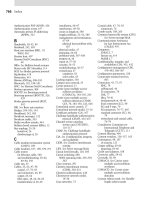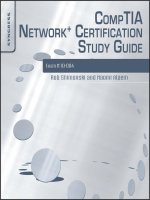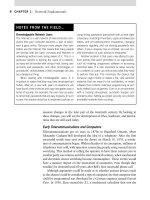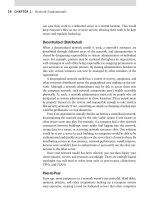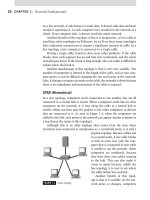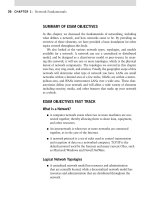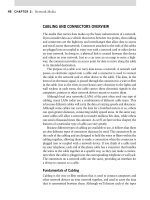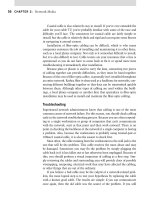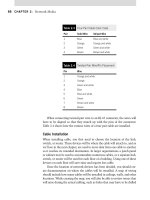CompTIA Network+ Certification Study Guide part 43 pot
Bạn đang xem bản rút gọn của tài liệu. Xem và tải ngay bản đầy đủ của tài liệu tại đây (178.11 KB, 10 trang )
CHAPTER 9: Security Standards and Services 406
that house an Structured Query Language (SQL) 2005 database. Figure 9.4
provides an example of this concept.
DMZs
In computer security, a DMZ is a “neutral” network segment where systems
accessible to the public Internet are housed, which offers some basic levels
of protection against attacks. The term DMZ is derived from the military
and is used to describe a “safe” or buffer area between two countries where,
by mutual agreement, no troops or war-making activities are allowed. In the
following sections, we will explore this concept in more detail.
DMZ Design
There are usually strict rules regarding what is allowed within a zone. When
you are applying this term to the IT security realm, it can be used to create
DMZ segments in usually one of two ways:
Layered DMZ implementation
Multiple interface firewall implementation
In the first method, the systems that require protection are placed
between two firewall devices with different rule sets, which allow systems
on the Internet to connect to the offered services on the DMZ systems, but
prevent them from connecting to the computers on the internal segments
of the organization’s network (often called the protected network).
FIGURE 9.4
The Complex N-Tier
Arrangement.
Security Zones 407
The second method is to add a
third interface to the firewall and
place the DMZ systems on that net-
work segment (see Figure 9.5). As an
example, this is the way Cisco PIX
firewalls are designed. This design
allows the same firewall to manage
the traffic between the Internet, the
DMZ, and the protected network.
Using one firewall instead of two
lowers the costs of the hardware and
centralizes the rule sets for the net-
work, making it easier to manage
and troubleshoot problems. Cur-
rently, this multiple interface design
is a common method for creating a
DMZ segment.
In either case, the DMZ systems are offered some level of protection
from the public Internet while they remain accessible for the specific services
they provide to external users. In addition, the internal network is protected
by a firewall from both the external network and the systems in the DMZ.
Because the DMZ systems still offer public access, they are more prone to
compromise, and thus, they are not trusted by the systems in the protected
network. A good first step in building a strong defense is to harden the
DMZ systems by removing all unnecessary services and unneeded compo-
nents. The result is a bastion host. This scenario allows for public services
while still maintaining a degree of protection against attack.
FIGURE 9.5 A Multiple Interface Firewall DMZ
Implementation.
Exam Warning
Hosts located in a DMZ are generally accessed from both internal network clients and
public (external) Internet clients. Examples of DMZ bastion hosts are DNS, Web, and FTP
servers. A bastion host is a system on the public side of the firewall, which is exposed
to attack. The word bastion comes from sixteenth-century French word, meaning the
projecting part of a fortress wall that faces the outside and is exposed to attackers.
The role of the firewall in all these scenarios is to manage the traffic
between the network segments. The basic idea is that other systems on the
Internet are allowed to access only the services of the DMZ systems that
have been made public. If an Internet system attempts to connect to a ser-
vice not made public, the firewall drops the traffic and logs the information
CHAPTER 9: Security Standards and Services 408
about the attempt (if configured to do so). Systems on a protected network
are allowed to access the Internet as they require, and they may also access
the DMZ systems for managing the computers, gathering data, or updating
content. In this way, systems are exposed only to attacks against the ser-
vices that they offer and not to underlying processes that may be running
on them.
The systems in the DMZ can host any or all of the following services:
Internet Web Site Access IIS or Apache servers that provide Web
sites for public and private usage. Examples would be www.microsoft
.com or www.netserverworld.com. Both of these Web sites have both
publicly and privately available contents.
FTP Services FTP file servers that provide public and private down-
loading and uploading of files. Examples would be the FTP servers
used by popular download providers at www.downloads.com or
www.tucows.com. FTP is designed for faster file transfer with less
overhead but does not have all the special features that are available
in HTTP, the protocol used for Web page transfer.
E-mail Relaying A special e-mail server that acts as a middleman
of sorts. Instead of e-mail passing directly from the source server
to the destination server (or the next hop in the path), it passes
through an e-mail relay that then forwards it. E-mail relays are a
double-edged sword and most security professionals prefer to have
this function disabled on all publicly accessible e-mail servers. On
the other hand, some companies have started offering e-mail relay-
ing services to organizations as a means of providing e-mail security.
DNS Services A DNS server might be placed in the DMZ to point
incoming access requests to the appropriate server with the DMZ.
This can alternatively be provided by the Internet service provider
(ISP), usually for a nominal extra service charge. If DNS servers
are placed in the DMZ, it is important to be careful and ensure
that they cannot be made to conduct a zone transfer (a complete
transfer of all DNS zone information from one server to another)
to any server. This is a common security hole found in many
Exam Warning
Remember that FTP has significant security issues in that username, and password
information is passed in clear text and can easily be sniffed.
Security Zones 409
publicly accessible DNS servers. Attackers typically look for this
vulnerability by scanning to see if port TCP 53 is open. When you
are placing a DNS server into the DMZ, it is often a good idea to
examine the usage of split horizon DNS. Split-horizon DNS is when
there are two authoritative sources for your domain namespace and
the contents of the databases differ depending on whether the server
is serving internal or external queries. Split-horizon DNS adds secu-
rity to the environment since the external database that may reside
in the DMZ would only contain records that would be appropriate
to expose while the internal database would be protected on the
LAN.
Intrusion Detection The placement of an IDS (discussed later in
this chapter) in the DMZ is difficult and depends on the network
requirements. IDSs placed in the DMZ will tend to give more false
positive results than those inside the private internal network
due to the nature of Internet traffic and the large number of script
kiddies out there. To reduce the larger number of false positives,
as the administrator you must perform IDS tuning. IDS tuning is
the process of adjusting the settings on your IDS so that it is more
appropriately configured to recognize normal traffic patterns in
your environment. This allows the system to better detect truly
unusual traffic circumstances for your network and alert you less
frequently for false positives. Still, placing an IDS on the DMZ can
give administrators early warning of attacks taking place on their
network resources.
The rise of e-commerce and the increased demand of online transactions
have increased the need for secure architectures and well-designed DMZs.
E-commerce requires more attention to be paid to securing transaction
information that flows between consumers and the sites they use, as well as
between e-commerce businesses themselves. Customer names, addresses,
order information, and especially financial data need greater care and
handling to prevent unauthorized access. This greater care is accomplished
through the creation of the specialized segments mentioned earlier (which
are similar to the DMZ) called security zones. Other items, such as the
use of encryption, and the use of secure protocols, such as SSL and Trans-
port Layer Security (TLS), are also important when designing a more secure
architecture.
Security requirements for storing customer information and financial
data are different from the requirements for storing routine, less-sensitive
information that businesses handle. Because this data requires processing
CHAPTER 9: Security Standards and Services 410
and much of the processing is done over the Internet, more complicated
network structures must be created. Many organizations choose to imple-
ment a multiple segment structure to better manage and secure their
different types of business information.
This multisegment approach allows flexibility because new segments
with specific purposes and security requirements can be easily added to the
model. In general, the two segments that are widely accepted are as follows:
A segment dedicated to information storage
A segment specifically for the processing of business information
Each of these two new segments has special security and operability
concerns above and beyond those of the rest of the organizational intra-
net. In reality, everything comes down to dollars – what is it going to cost
to implement a security solution versus what will it cost if the system is
breached by attackers. Thus, the value of raw data is different than the value
of the financial processing system. Each possible solution has its pluses and
minuses, but in the end, a balance is struck between cost versus expected
results; thus, the creation of different zones (segments) for different pur-
poses. Note that in this example, the Web and e-mail servers would likely
receive the least amount of spending and security measures, which is not
to say that they will be completely ignored, they just would not receive as
much as the financial servers might.
Creation of multiple segments changes a network structure to look like
the drawing in Figure 9.6.
Remember that by adding additional
zones, you are also adding additional over-
head. In this scenario, all traffic must tra-
verse firewall rules to move between zones.
The diagram shown in Figure 9.6 includes
the following two new zones:
The data storage network
The financial processing network
The data storage zone is used to hold
information that the e-commerce applica-
tion requires, such as inventory databases,
pricing information, ordering details, and
other nonfinancial data. The Web servers in
the DMZ segment serve as the interface to
the customers; they access the servers in the
FIGURE 9.6 A Modern E-Commerce Implementation.
Security Zones 411
other two segments to gather the required information and to process the
users’ requests.
When an order is placed, the business information in these databases
is updated to reflect the real-time sales and orders of the public. These
business-sensitive database systems are protected from the Internet by the
firewall, and they are restricted from general access by most of the systems
in the protected network. This helps protect the database information from
unauthorized access by an insider or from accidental modification by an
inexperienced user.
The financial information from an order is transferred to the financial
processing segment. Here, the systems validate the customer’s informa-
tion and then process the payment requests to a credit card company, a
bank, or a transaction clearinghouse. After the information has been pro-
cessed, it is stored in the database for batch transfer into the protected
network, or it is transferred in real time, depending on the setup. The
financial segment is also protected from the Internet by the firewall, as
well as from all other segments in the setup. This system of processing
the data in a location separate from the user interface creates another
layer that an attacker must penetrate to gather financial information about
customers. In addition, the firewall protects the financial systems from
access by all but specifically authorized users inside a company.
Access controls also regulate the way network communications are initi-
ated. For example, if a financial network system can process credit informa-
tion in a store-and-forward mode, it can batch those details for retrieval by
a system from the protected network. To manage this situation, the firewall
permits only systems from the protected network to initiate connections
with the financial segment. This prevents an attacker from being able to
directly access the protected network in the event of a compromise. On the
other hand, if the financial system must use real-time transmissions or data
from the computers on the protected network, the financial systems have
to be able to initiate those communications. In this event, if a compromise
occurs, the attacker can use the financial systems to attack the protected
network through those same channels. It is always preferable that DMZ
systems not initiate connections into more secure areas, but that systems
with higher security requirements initiate those network connections. Keep
Test Day Tip
You will not need to know how an e-commerce DMZ is set up to pass the Network+ exam;
however, it is important to know this information for real-world security work.
CHAPTER 9: Security Standards and Services 412
this in mind as you design your network segments and the processes that
drive your site.
In large installations, these segments may vary in placement, number,
and/or implementation, but this serves to generally illustrate the ideas
behind the process. An actual implementation may vary from this design.
For example, an administrator may wish to place all the financial processing
systems on the protected network. This is acceptable as long as the requi-
site security tools are in place to adequately secure the information. Other
possible implementations include segmenting business information off an
extension of the DMZ, as well as discrete DMZ segments for development
and testing. Specific technical requirements will impact actual deployment,
so administrators may find that what they currently have in place on a
network (or the need for a future solution) may deviate from the diagrams
shown earlier. The bottom line is to ensure that systems are protected.
Some common problems do exist with multiple-zone networks. By their
very nature, they are complex to implement, protect, and manage. Firewall
rule sets are often large, dynamic, and confusing, and the implementation
can be arduous and resource intensive.
Creating and managing security controls such as firewall rules, IDS sig-
natures, and user-access regulations is a large task. These processes should
be kept as simple as possible without compromising security or usability.
It is best to start with deny-all strategies and permit only the services and
network transactions required to make the site function, and then carefully
manage the site’s performance making small changes to the access controls
to more easily manage the rule sets. Using these guidelines, administra-
tors should be able to quickly get the site up and running without creating
obvious security holes in the systems.
Test Day Tip
The phrase store-and-forward refers to a method of delivering transmissions in which
the messages are temporarily held by an intermediary before being sent on to their final
destination. Some switches and many e-mail servers use the store-and-forward method
for data transfer.
Exam Warning
A denial all strategy means that all services and ports are disabled by default and then
only the minimum level of service is activated as a valid business case is made for each
service.
Security Zones 413
As a site grows and offers new features, new zones may have to be cre-
ated. The above process should be repeated for creating the rule sets gov-
erning these new segments. As always, it is important to audit and inspect
any changes and keep backups of the old rule sets, in case they are needed
again.
The Future of DMZs
DMZs are evolving as the landscape of the Internet changes with today’s
world. With things such as cloud computing and hosted services gaining
popularity, many organizations are taking the time to evaluate their existing
DMZ deployments and attempting to reduce the footprint of DMZ in their
organizations.
As long as services are hosted onsite in environments and the services
have a need for accessibility from the Internet or from other organizations,
the DMZs of the world will continue to be designed and deployed.
VPNs
VPNs offer the allure of being physically present in one location while behav-
ing as if attached to the local network of a different location entirely. To truly
be a VPN, the traffic shared among devices on the VPN must be protected,
so as to provide confidentiality, integrity, and authentication (see Figure 9.7).
Confidentiality satisfies the privacy aspect that implies outsiders should
not be able to see traffic, integrity satisfies the privacy aspect that outsiders
should not be able to change or prevent the network traffic, and authentica-
tion satisfies the aspect of privacy that says you have to be able to distinguish
between insiders and outsiders.
Point-to-Point Tunneling Protocol
Point-to-Point Tunneling Protocol (PPTP) is the oldest of the VPNs under
consideration here and unsurprisingly is the least fully-featured or secure by
itself.
PPTP, described in RFC 2637, is a relatively simple encapsulation of the
Point-to-Point Protocol (PPP) over an existing TCP/IP connection. It consists
of two connections (perhaps more in multilink environments, although this
is less common today) – the control connection is a TCP connection to port
1,723, and the IP tunnel connection is carried over the Generic Routing
Encapsulation (GRE) Protocol, carrying the user’s data itself.
Exam Warning
Make sure you know the definitions of and the differences between a firewall and a DMZ.
CHAPTER 9: Security Standards and Services 414
PPTP connections can be estab-
lished in either direction, although it is
more common in the TCP/IP case for
a client to initiate the connection – the
call-back scenario was more commonly
supported for dial-up access to systems.
The control connection is established
first, and a Start-Connection-Request
message is sent, which the other party
responds to with a Start-Connection-
Reply message.
Once the control connection itself
has been established using these mes-
sages, the client sends an Incoming-
Call-Request message to the server,
requesting that a tunnel connection be
created. The server responds with an
Incoming-Call-Reply message, which
the client needs to acknowledge with
an Incoming-Call-Connect message.
These Incoming-Call messages negoti-
ate a pair of random Call ID numbers
associated with each end of the connec-
tion – these Call IDs uniquely identify
traffic in the GRE tunnel so that the
same tunnel can contain multiple Call
IDs, in case multiple users need to make
VPN connections to the same server.
The GRE data traffic then can begin and consists simply of PPP packets
encapsulated in the GRE header. The Call ID is included in the Key field of
the GRE header, along with the packet’s length, and an optional sequence
number and acknowledgement number.
Closure begins with a Stop-Connection-Request, which the other party
responds to with a Stop-Connection-Reply, after which the TCP connection
between client and server is severed. To prevent resources being used by an
inactive session, a “keepalive” or echo packet is sent periodically – if the
keepalive has not been received or responded to in 60s, either side may
disconnect the TCP connection and discard any further traffic through the
GRE protocol for that connection.
As you can tell from the description, this is a very simple protocol and
does not consider security in itself. Security requirements of PPTP are left
to the PPP portion of the traffic.
FIGURE 9.7 A VPN in Use.
Security Zones 415
PPTP connections can be authenticated through the PPP layer using
the Microsoft Challenge Handshake Authentication Protocol (MSCHAP) or
the Extensible Authentication Protocol Transport Layer Security (EAP-TLS)
Protocol. Encryption can be provided by the Microsoft Point-to-Point Encryp-
tion (MPPE) protocol, which is based on RC4 with session keys of 40-bit,
56-bit, or 128-bit length.
Because PPTP is so simple, it is frequently implemented, even in non-
Microsoft OSs such as Mac OS X and Linux. As a simple protocol, it is ideal
for small low-power devices, such as mobile phones and personal digital
assistants (PDAs).
PPTP’s biggest failing, besides its passing of security considerations to
the underlying PPP protocol, is that it uses a protocol (GRE) other than
TCP or UDP, which may be blocked at firewalls, network address translator
(NATs), and routers.
Layer 2 Tunneling Protocol
Layer 2 Tunneling Protocol (L2TP) was defined originally in RFC 2661, with
the current version, L2TPv3, defined in RFC 3931. The name refers to the
fact that Layer 2 (the same layer as Ethernet) traffic is tunneled over UDP, a
Layer 4 protocol.
Unlike PPTP, L2TP uses one data stream only, on UDP port 1701. L2TP
packets are divided between control and data by a flag in the header. Because
L2TP operates over UDP, it has to implement its own acknowledgement and
retransmission mechanisms for the control messages it uses.
Like PPTP, L2TP uses PPP to encapsulate data traffic that is sent across
the tunnel, and connections, or “calls” are created and torn down over the
implied circuit created by the UDP traffic to port 1,701 at the server. The
server responds to whatever port the client sent its UDP messages from – this
may be port 1,701 but is generally a random port number.
Instead of Connections and Calls, L2TP sets up Tunnels and Sessions,
for similar purposes.
The L2TP negotiation consists of data exchanged over UDP, beginning
with a Start-Control-Connection-Request, containing a Tunnel ID used by
the initiator to identify its end of the connection. The recipient responds to
this with a Start-Control-Connection-Reply, containing its own Tunnel ID
and acknowledging the Tunnel ID of the initiator. The initiator then sends
a Start-Control-Connection-Connected message, indicating that it accepts
the Tunnel ID from the recipient.
Just as in the PPTP case, the negotiation continues from this point to
establish a Call, beginning with an Outgoing-Call-Request, followed by an
Outgoing-Call-Reply. These messages contain the session IDs to which this
call is associated, as well as a Remote End ID value (also known in some
